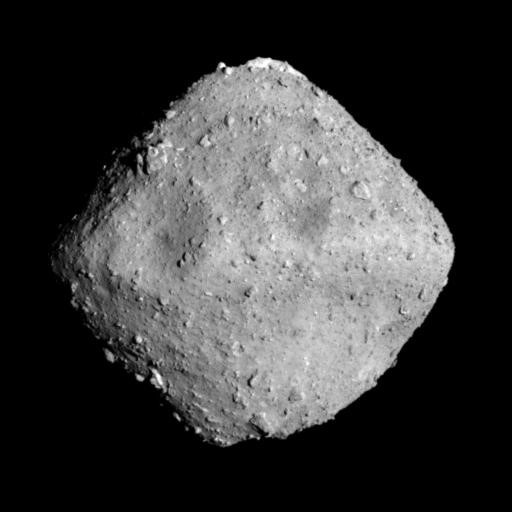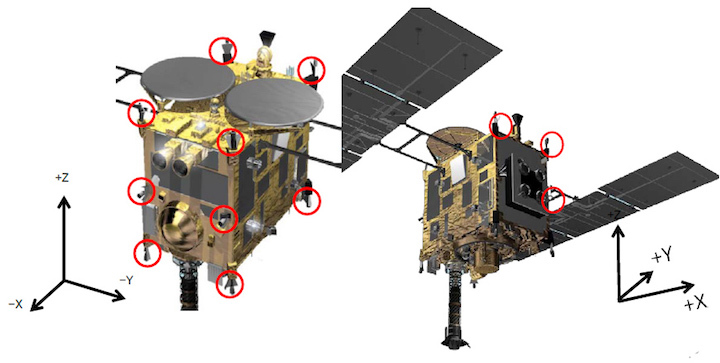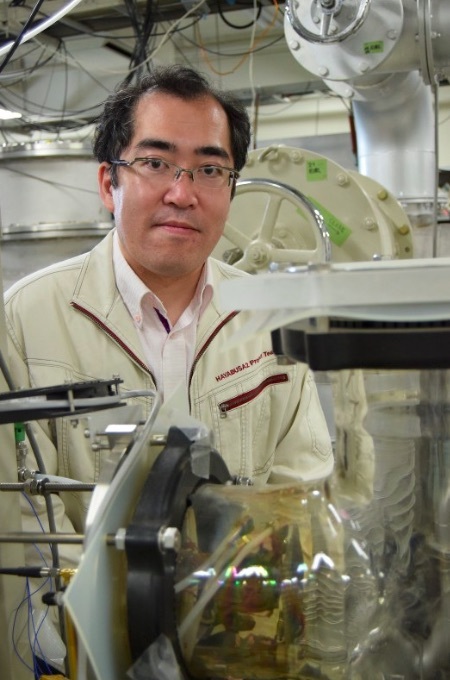24.06.2018
Hayabusa 2 space probe adjusts course, enters final leg to Ryugu asteroid
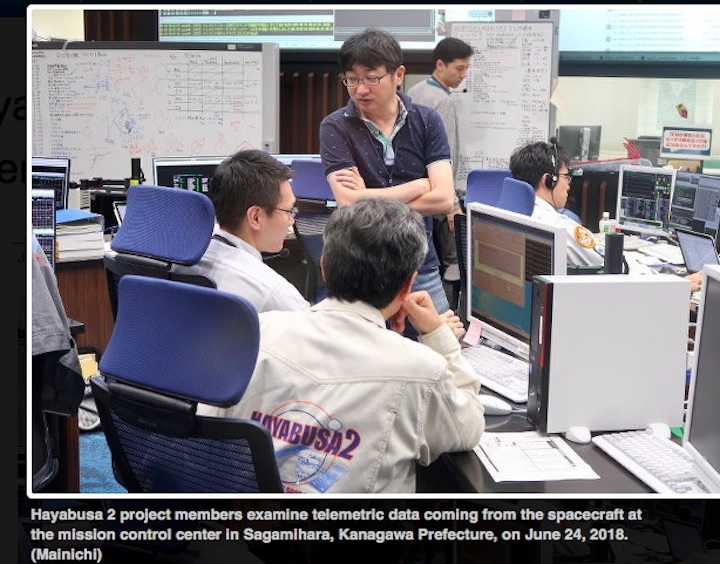

A computer screen at the JAXA mission control room in Sagamihara, Kanagawa Prefecture, shows speed data sent by the Hayabusa 2 probe on June 24, 2018. (Mainichi)
-
SAGAMIHARA, Kanagawa -- Japan's Hayabusa 2 space probe has successfully completed a course adjustment and entered the final leg of its 4.5-year journey to the asteroid Ryugu for a planned arrival on June 27, the Japan Aerospace Exploration Agency (JAXA) said on June 24.
The probe will make two more minor course corrections before it reaches a point about 20 kilometers from the asteroid. The craft was about 36 kilometers from Ryugu as of 6 p.m. on June 24, according to JAXA.
The latest course adjustment was managed from the JAXA mission control center in Sagamihara. Commands to fire chemical thrusters twice at 9:35 and 9:40 a.m. for speed reduction and course change were transmitted to the probe, which is about 300 million kilometers from Earth. Because of the distance, it took a total of about 32 minutes for the commands to reach the Hayabusa and for the spacecraft to send back the telemetric data about the completion of the maneuvers.
When project manager Yuichi Tsuda confirmed the data and judged that the planned maneuvers had been successful, the room filled with applause and smiles.
Additional course corrections will be carried out on June 26 and 27, respectively. The first one will slow the probe's relative speed to that of the asteroid to almost zero, and the last adjustment will bring the spacecraft to its destination of about 20 kilometers above Ryugu.
The Hayabusa 2 explorer is scheduled to make three landings on the asteroid to collect samples starting in November, and return to Earth around the end of 2020.
Quelle: The Mainichi
---
Update: 25.06.2018
.
JAXA: Hayabusa 2 probe should arrive at asteroid Ryugu on morning of June 27

The Japan Aerospace Exploration Agency (JAXA) announced on June 25 that its Hayabusa 2 space explorer is now estimated to arrive at the asteroid Ryugu on the morning of June 27.
The spacecraft, flying about 300 million kilometers away from Earth, is traveling at a relative speed of 8 centimeters per second toward the asteroid, which is some 30 kilometers away. Following its arrival at a point 20 kilometers from Ryugu, Hayabusa 2 will conduct extensive observations of the asteroid's surface and structure before making a first landing attempt in the fall of this year.
Quelle: The Mainichi
+++
Japan’s Hayabusa 2 closes in on diamond-shaped asteroid Ryugu
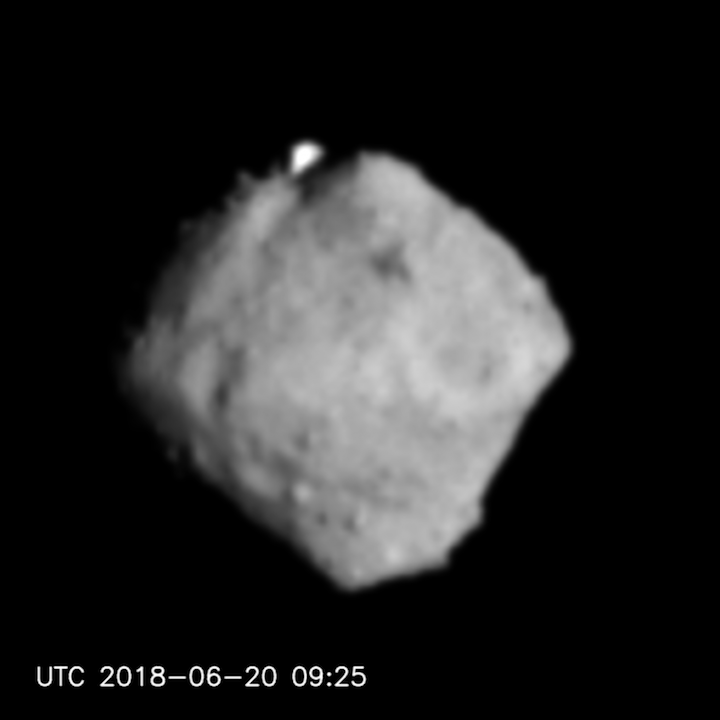
The closest view of Ryugu released so far, from a distance of only 62 miles (100 kilometers), on June 20, 2018, showing a rough diamond shape, craters and boulders, as well as a bright spot bear the top point of the diamond. Image via JAXA/University of Tokyo/Kochi University/Rikkyo University/Nagoya University/Chiba Institute of Technology/Meiji University/University of Aizu/AIST.
Japan’s Hayabusa 2 spacecraft is now rapidly approaching asteroid Ryugu, providing the first-ever close-up views of this near-Earth object. According to The Mainichi, a news source covering the encounter from Japan, the Japan Aerospace Exploration Agency (JAXA) said on June 24, 2018, that the Hayabusa 2 space probe has successfully completed a course adjustment and entered the final leg of its 4.5-year journey to the asteroid. Its planned arrival will be on June 27. Meanwhile, JAXA has also released a new set of images, showing a roughly diamond-shapedbody – also being compared to a spinning top – with boulders and craters.
As of June 24, the most recently released images are from a distance of 136-62 miles (220-100 km). A bright spot can be seen near the top point of the diamond (shades of Ceres?) and what may be an equatorial ridge, something seen elsewhere in the solar system as well, such as on Saturn’s moon Iapetus and several other Saturn moons (Atlas, Pan, Daphnis).
The images are already showing quite a bit of detail, and of course, they will only get better as the spacecraft gets even closer!
Ryugu is small, with a diameter of about 2,788-2,887 feet (850 to 880 meters), and has an appearance similar to the asteroid Bennu, which the U.S. spacecraft OSIRIS-REx will encounter in 2020. Hayabusa 2 will attempt to send both a small lander and rovers to the surface of the asteroid, as well as bring samples back to Earth for study.
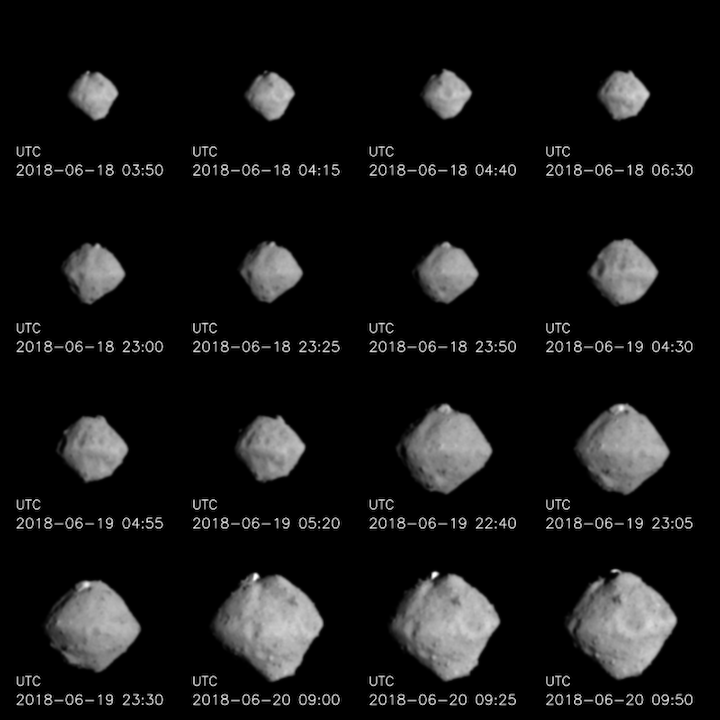
Additional images from Hayabusa 2’s approach, from June 18-20. Image via JAXA/University of Tokyo/Kochi University/Rikkyo University/Nagoya University/Chiba Institute of Technology/Meiji University/University of Aizu/AIST.
On June 19, Makoto Yoshikawa, the Hayabusa 2 mission manager for JAXA, said in a statement:
When I saw these images, I was surprised that Ryugu is very similar in shape to both the destination of the U.S. OSIRIS-REx mission, asteroid Bennu, and also the target of the previously proposed MarcoPolo-R mission by Europe, asteroid 2008 EV5. Bennu and 2008 EV5 are about half the diameter (and 1/8 the volume) of Ryugu, with rotation periods about half as long. In other words, these celestial bodies are small and rotating fast compared to Ryugu. On the other hand, Bennu is a B-type asteroid, which is very similar to C-type asteroids such as 2009 EV5 and Ryugu. Therefore there should also be common properties due to the asteroid type. So we have both differences and similarities that have combined to produce very similar shapes … why is that? I think this is very interesting. So far, the asteroids we have explored have been different in shape, so Ryugu and Bennu could be the first time two similar-shaped asteroids have been examined. It will be interesting to clarify exactly what this similarity means scientifically.
After Hayabusa 2 arrives at Ryugu, it will be only 12.5 miles (20 km) above the asteroid’s surface. Between this coming September and July of next year, one small lander (called MASCOT-1) and three small rovers (called MINERVA-II) will be deployed to the surface. Before then, however, the spacecraft will need to study the asteroid to find the best landing locations. As Yoshikawa noted:
If the axis of rotation for Ryugu is close to the vertical direction in this image, there is a big advantage as it will be possible to know almost the entire appearance of Ryugu at an early stage after arrival. This makes the project planning easier. However, it is also possible that potential landing sites may be limited to the equator of Ryugu. I hope we can find a suitable place to set down the lander and rovers.
Ryugu is already proving to be an interesting body, as described by optical navigation camera principal investigator Seiji Sugita:
As we approached Ryugu and were able to distinguish individual features in the asteroid’s topology, it became clear that Ryugu has a land of rich terrain. Numerous clusters of rock roll on the surface. Among these, a large rocky mass (about 150m across) stands out on the upper part of Ryugu due to its brighter color (higher reflectivity). The belt-shaped ring of peaks that surround the equator are also slightly brighter than their surroundings. This color difference may reflect a difference in material composition and the size of the particles that form the rock. We can also see many sunken regions that look like craters. These depressions may have been made in collisions with other celestial bodies. A structure that looks like a grove is also visible.
The existence of such varied topographies is an indication that Ryugu has undergone a complex evolutionary history. It is generally believed that small asteroids that are less than .6 miles (1 km), such as Ryugu, were created fairly recently in the solar system’s history (within several hundred million years) during the fragmentation of a larger parent body. Ryugu’s terrain will tell us about the division from the parent body and the asteroid’s subsequent evolution.
Hayabusa 2 is the second asteroid sample-return mission by JAXA. The first, Hayabusa, was launched in 2003 and arrived at the asteroid Itokawa in 2005. Despite some problems, 1,500 grains of rock from the asteroid were successfully returned to Earth in June 2010. Hayabusa 2 is scheduled to return its samples back to Earth in 2020.
Bottom line: We are now getting our first close-up look at a near-Earth asteroid called Ryugu, thanks to the Japanese spacecraft Hayabusa 2. Its “diamond” or “spinning top” shape might seem peculiar, but its shape is similar to that of another asteroid, Bennu, which will also receive its first earthly visitor, the U.S. spacecraft OSIRIS-REx, in 2020.
Quelle: EarthSky
---
Update: 26.06.2018
.
Japan’s Hayabusa2 Spacecraft Creeps Up on the Ryugu Asteroid
After a journey that started in 2014, the probe will reach the space rock on Wednesday to begin studying it for clues to the solar system’s origins.
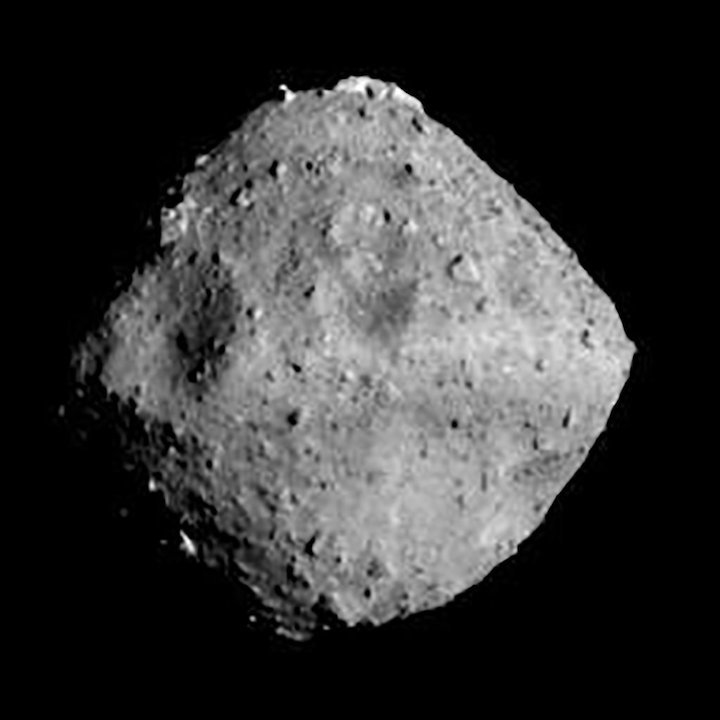
A view of the asteroid Ryugu captured by the Hayabusa2 spacecraft on Sunday, from a distance of about 40 kilometers.CreditJAXA, University of Tokyo, Kochi University, Rikkyo University, Nagoya University, Chiba Institute of Technology, Meiji University, Aizu University, AIST
-
Here’s the mission for Japan’s Hayabusa2 spacecraft in a nutshell: Fly to a carbon-rich asteroid between the orbits of Earth and Mars, study it for a year and a half and then bring back some pieces for additional study on Earth.
Like most space missions, that’s much easier said than done. Launched in 2014, Hayabusa2 is just now approaching its target, Ryugu, an asteroid about half a mile wide. The Japanese astronomers studying it say it has the shape of a top or even an abacus bead.
That’s a big improvement from earlier in June when it sent back a picture taken at a distance of about 1,600 miles — the asteroid then was just three pixels across and looked like something drawn in the blocky style of Minecraft.
Hayabusa2 is powered by ion engines, which accelerate charged atoms of xenon with an electric field to generate thrust.
Ion engines are a very efficient form of propulsion but not very powerful. That means Hayabusa2 can carry much less fuel than traditional thrusters would require, but it also means that it could not take a quick, direct route. The spacecraft used a flyby of Earth in December 2015 to accelerate and match its trajectory with the tilted orbit of the asteroid.
When will the spacecraft reach Ryugu?
As of Monday, the spacecraft is about 15 miles away, and it is scheduled to arrive around Wednesday coming within 12.5 miles of the space rock. It is currently creeping up to Ryugu at a relative velocity of about 4 inches per second.
Why are they studying this asteroid?

Asteroids are bits and pieces leftover from the disc of gas and dust that formed around the young sun and never quite coalesced into a planet. They contain some almost pristine compounds that help tell what the early solar system was like 4.5 billion years ago.
Ryugu, as dark as coal, is a C-type, or carbonaceous, asteroid, meaning it is full of carbon molecules known as organics including possibly amino acids, the building blocks of proteins. Such molecules are not always associated with biology and can form from chemical reactions in deep space, but asteroids could have seeded Earth with the organic matter that led to life.
About three-quarters of asteroids in the solar system fall into the C-type. And the time it takes for Ryugu to rotate came as a surprise to the scientists who are studying it.
“Up to now we know several top-shaped asteroids, but all of them have a short spin period around 3 hours,” said Makoto Yoshikawa, the Hayabusa2 mission’s manager. “The spin period of Ryugu is about 7.5 hours, so this issue is quite interesting from the point of science.”
This space rock was discovered in 1999 and not given a name until 2015. Ryugu is named after Ryugu-jo, or dragon’s palace — a magical undersea palace in a Japanese folk tale.
What will it do once it gets there?
If the spacecraft is able to keep its schedule, by the end of July, Hayabusa2 will descend within 3.1 miles of Ryugu’s surface to measure the gravity field around the asteroid. In September or October, Hayabusa2 is scheduled to make its first “touchdown operation” on the asteroid.
At that point, it may deploy one or more of the three tiny rovers it is carrying. It may also deploy a European-built lander then.
Then it’ll take a hiatus in November and December, because the sun will be directly between Ryugu and Earth, blocking communications.
After that, the spacecraft will make a couple more touchdowns, as well as dropping a copper projectile into the asteroid to create a crater. That will allow the spacecraft to collect some material from beneath the surface. (The projectile is made of copper, because that metal is easily distinguishable from what the asteroid is made of.)
At the end of 2019, Hayabusa2 is to leave the asteroid and head back to Earth. As it flies by in 2020, it’ll drop off a capsule with the asteroid samples.
Isn’t NASA doing something like this too?
Yes. The Osiris-Rex spacecraft is currently heading to another carbon-rich asteroid known as Bennu, and it too will collect samples and return them to Earth. Bennu is even smaller than Ryugu, about 500 yards wide. Osiris-Rex will begin its approach of Bennu in August, and start surveying the asteroid at a distance in October; it will not return with its samples until 2023.

NASA Launches the Osiris-Rex Spacecraft to Asteroid Bennu
Osiris-Rex launched Sept. 8, 2016, on a seven-year mission to the asteroid Bennu.
NASA and Japanese scientists plan to exchange samples of the two asteroids to compare the similarities and differences.
Has Japan done this before?

As the 2 in Hayabusa2 indicates, this is the second time that JAXA, the Japanese space agency, has sent a spacecraft to an asteroid.
Hayabusa2 is an improved version of Hayabusa, which visited a stony asteroid, Itokawa, in 2005. Despite several technical problems at Itokawa, Hayabusa returned a capsule to Earth in 2010 containing 1,500 particles from the asteroid.
Quelle: The New York Times
---
Update: 27.06.2018
.
Japanese space probe arrives at asteroid to collect samples
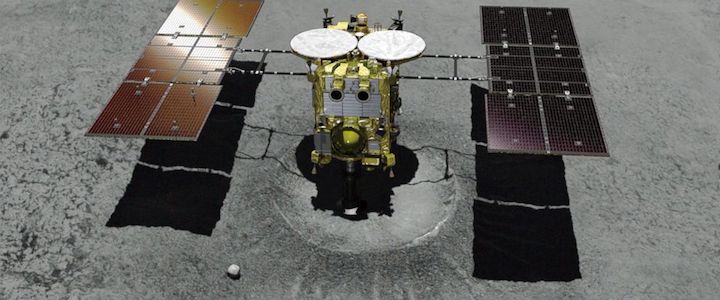
This computer graphics image provided by the Japan Aerospace Exploration Agency (JAXA) shows asteroid explorer Hayabusa2 landing on a crater that it made. The Japanese space explorer that will try to blow a crater in an asteroid and bring back samples from inside is nearing its destination after a 3 1/2 -year journey. The unmanned Hayabusa2 has arrived at the asteroid Wednesday, June 27, 2018, about 280 million kilometers (170 million miles) from Earth. (JAXA via AP)
-
A Japanese space probe arrived at an asteroid Wednesday after a 3 1/2-year journey to undertake a first-ever experiment: blow a crater in the rocky surface to collect samples and bring them back to Earth.
The unmanned Hayabusa2 spacecraft reached its base of operations about 20 kilometers (12 miles) from the asteroid and some 280 million kilometers (170 million miles) from Earth, the Japan Aerospace Exploration Agency said.
Over the next year and a half, the robotic explorer will attempt three brief touch-and-go landings to collect samples. If the retrieval and the return journey are successful, the asteroid material could provide clues to the origin of the solar system and life on Earth.

 An artist’s rendition of Japan’s Hayabusa 2 space probe and the “spinning top” asteroid Ryugu (Provided by Akihiro Ikeshita)
An artist’s rendition of Japan’s Hayabusa 2 space probe and the “spinning top” asteroid Ryugu (Provided by Akihiro Ikeshita)

